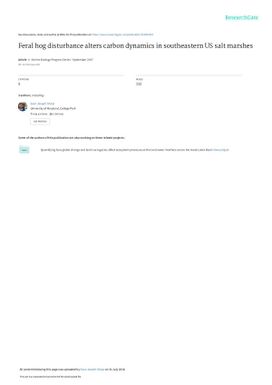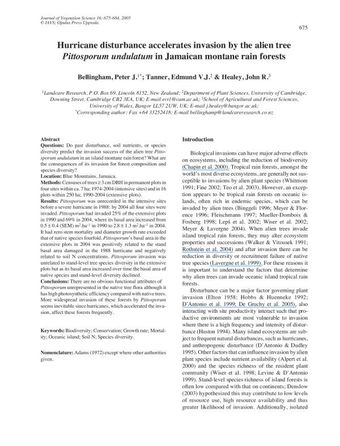Feral hog disturbance alters carbon dynamics in Southeastern US salt marshes
- Description:
- Disturbances that remove primary producers and alter substrate chemistry commonly influence ecosystem carbon dynamics. Because coastal wetlands are especially effective in sequestering carbon, quantifying how disturbances may alter their ability to perform this climate-regulating function is important for assessing their carbon storage potential. Here, we quantified soil respiration, litter decomposition, and soil organic carbon (SOC), as a proxy for carbon storage, in areas disturbed by invasive feral hogs Sus scrofa and in adjacent, undisturbed areas within 3 southeastern US salt marshes. Contrary to our hypothesis that hog overturning of soils would stimulate soil respiration, this metric was lower and both surface and subsurface litter decomposition rates were similar in disturbed relative to undisturbed areas across all sites. SOC was lower in disturbed versus undisturbed areas at 2 sites as hypothesized, but higher at 1 site. Surveys and analyses reveal that lower and less variable infauna, plant, and benthic algae densities likely suppressed soil respiration in hog-disturbed versus undisturbed areas, while the offsetting effects of lower invertebrate densities and higher soil temperature likely caused decomposition to be consistent within and outside of disturbed areas. . These findings suggest that hog removal of plants and disruption of soils can cause tracts of marsh to transition from carbon sinks to sources where these disturbances are intense enough to prohibit rapid plant recovery and promote the gradual respiration of carbon stocks from denuded soils.
- Display date:
- 2017
- Collections:
- Secretariat of the Pacific Regional Environment Programme (SPREP)
- Publisher:
- Marine Ecology Progress Series
- Content partner:
- Secretariat of the Pacific Regional Environment Programme (SPREP)
- Availability:
- Not specified
-
Copyright status: All rights reservedFind out more about what you are able to do with this itemThis item is all rights reserved, with means you'll have to get permission from Secretariat of the Pacific Regional Environment Programme (SPREP) before using it. For more information, please see our use and reuse page.What can I do with this item?Non-infringing useNZ copyright law does not prevent every use of a copyright work, and this item may be hosted by an international institute or organisation. You should consider what you can and cannot do with a copyright work.No sharingYou may not copy and/or share this item with others without further permission. This includes posting it on your blog, using it in a presentation, or any other public use.No modifyingYou are not allowed to adapt or remix this item into any other works.No commercial useYou may not use this item commercially.
Related items
Welcome and warm Pasifik greetings
The information on this site has been gathered from our content partners.
The names, terms, and labels that we present on the site may contain images or voices of deceased persons and may also reflect the bias, norms, and perspective of the period of time in which they were created. We accept that these may not be appropriate today.
If you have any concerns or questions about an item, please contact us.

